AMD FX-8370E CPU Review: Vishera Down to 95W, Price Cuts for FX
by Ian Cutress on September 2, 2014 8:00 AM ESTCPU Benchmarks
The dynamics of CPU Turbo modes, with both Intel and AMD, can cause concern during environments with a variable threaded workload. There is also an added issue of the motherboard remaining consistent, depending on how the motherboard manufacturer wants to add in their own boosting technologies over the ones that Intel would prefer they used. In order to remain consistent, we implement an OS-level unique high performance mode on all the CPUs we test which should override any motherboard manufacturer performance mode.
HandBrake v0.9.9: link
For HandBrake, we take two videos (a 2h20 640x266 DVD rip and a 10min double UHD 3840x4320 animation short) and convert them to x264 format in an MP4 container. Results are given in terms of the frames per second processed, and HandBrake uses as many threads as possible.
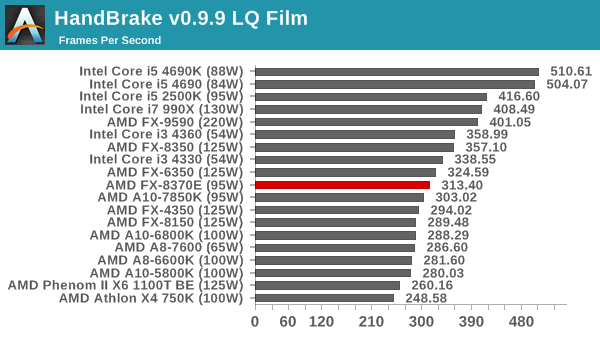
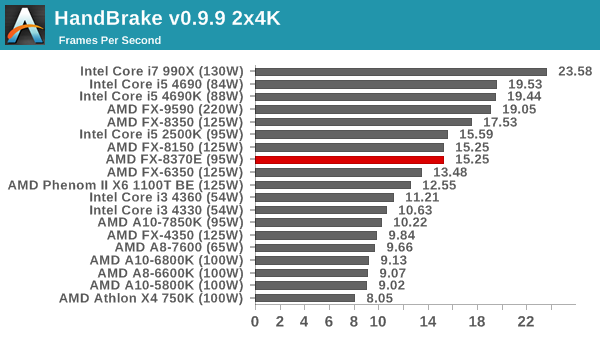
Handbrake balances cores and frequency, with the LQ film test often condensing CPUs based on frequency and the double UHD test expanding by cores. The double UHD test puts the 8370E at the bottom of the AMD 8-thread CPUs as expected.
Agisoft Photoscan – 2D to 3D Image Manipulation: link
Agisoft Photoscan creates 3D models from 2D images, a process which is very computationally expensive. The algorithm is split into four distinct phases, and different phases of the model reconstruction require either fast memory, fast IPC, more cores, or even OpenCL compute devices to hand. Agisoft supplied us with a special version of the software to script the process, where we take 50 images of a stately home and convert it into a medium quality model. This benchmark typically takes around 15-20 minutes on a high end PC on the CPU alone, with GPUs reducing the time.
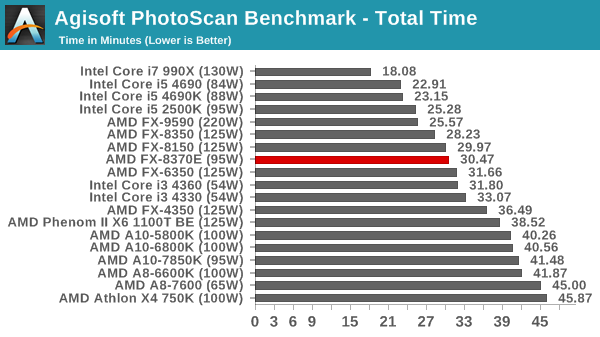
Photoscan results seem to take the following order: i7, i5, FX (8), FX (6), i3, FX (4), A10, A8. The 8370E sits at the bottom of the FX 8-thread section as before.
WinRAR 5.0.1: link

WinRAR takes advantage of all the AMD threads due to its integer workloads.
PCMark8 v2 OpenCL
A new addition to our CPU testing suite is PCMark8 v2, where we test the Work 2.0 and Creative 3.0 suites in OpenCL mode. As this test is new, we have not run it on many AMD systems yet and will do so as soon as we can.

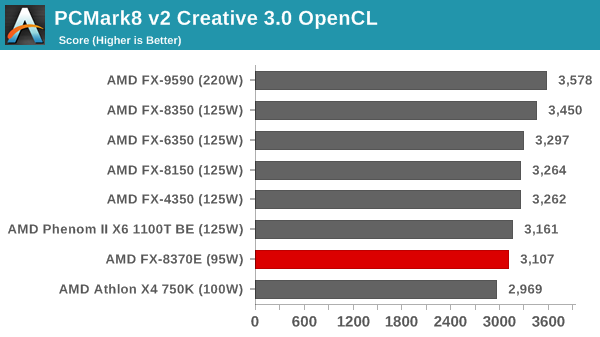
The PCMark8 tests both seem to favor frequency at this point, with the FX-9590 taking the lead.
Hybrid x265
Hybrid is a new benchmark, where we take a 4K 1500 frame video and convert it into an x265 format without audio. Results are given in frames per second.
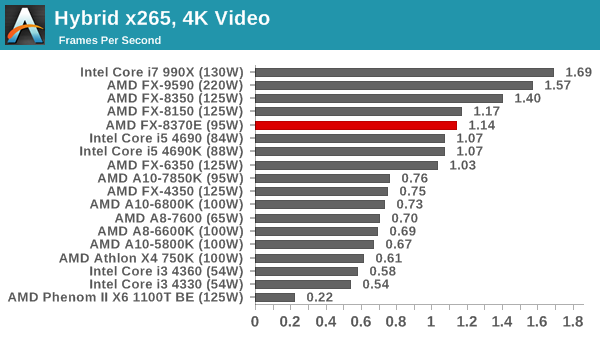
Again, more threads gives an intesting workload. The FX-8370E beats out the i5-4690K as well.
Cinebench R15
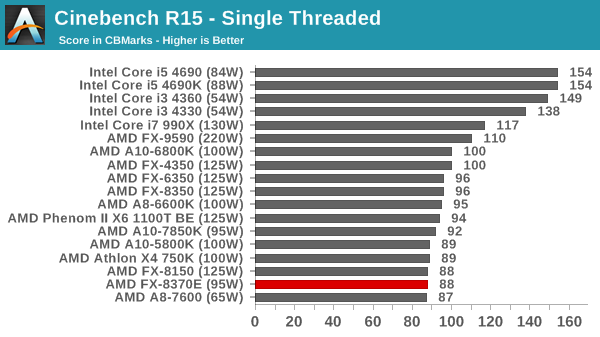

Unfortunately the Achilles heel strikes again in single threaded performance. Multithreaded puts it just behind the FX-8150.
3D Particle Movement
3DPM is a self-penned benchmark, taking basic 3D movement algorithms used in Brownian Motion simulations and testing them for speed. High floating point performance, MHz and IPC wins in the single thread version, whereas the multithread version has to handle the threads and loves more cores.

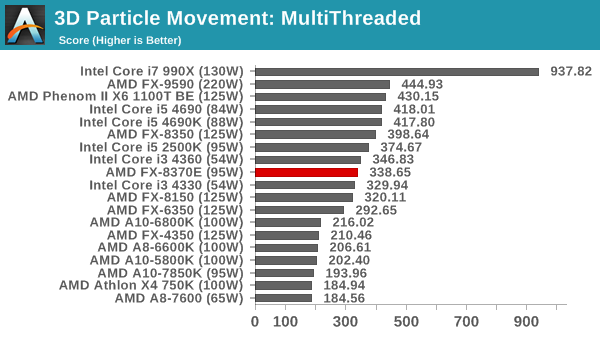
FastStone Image Viewer 4.9
FastStone is the program I use to perform quick or bulk actions on images, such as resizing, adjusting for color and cropping. In our test we take a series of 170 images in various sizes and formats and convert them all into 640x480 .gif files, maintaining the aspect ratio. FastStone does not use multithreading for this test, and results are given in seconds.
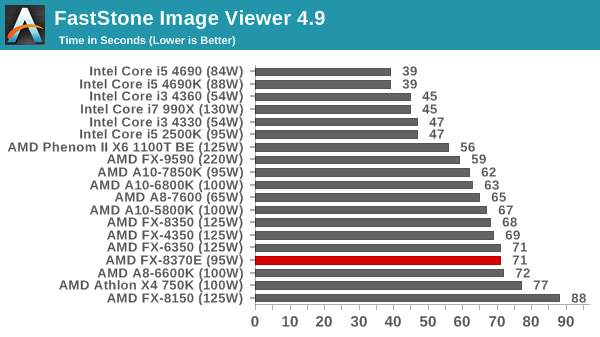
Web Benchmarks
On the lower end processors, general usability is a big factor of experience, especially as we move into the HTML5 era of web browsing. For our web benchmarks, we take four well known tests with Chrome 35 as a consistent browser.
Sunspider 1.0.2
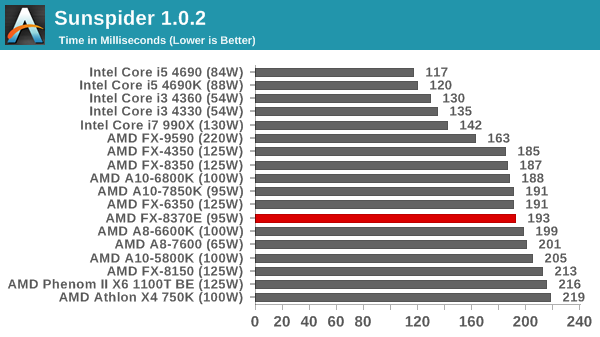
Mozilla Kraken 1.1
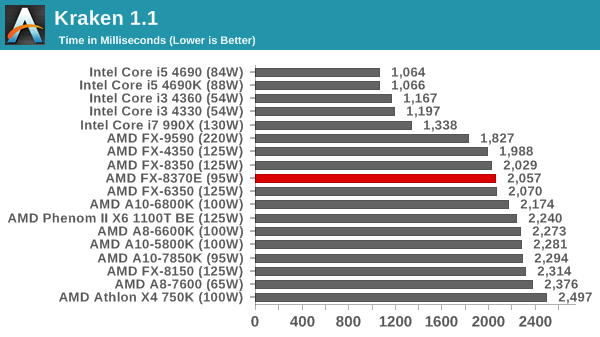
WebXPRT
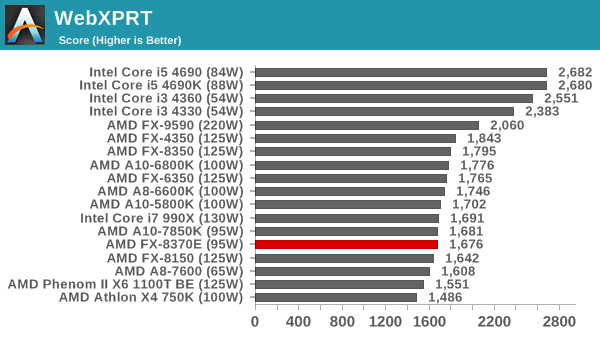
Google Octane v2
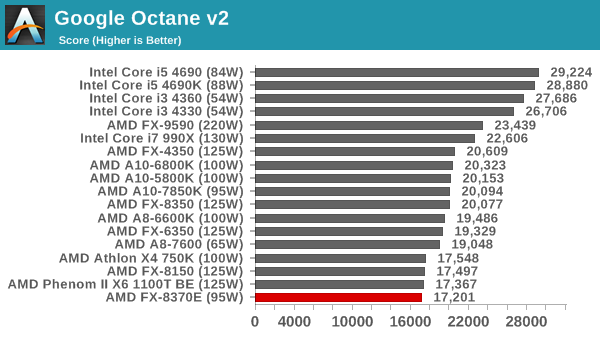










107 Comments
View All Comments
silverblue - Tuesday, September 2, 2014 - link
I remember a B3 stepping that never surfaced; perhaps the process improvements were baked into C0 along with the architectural tweaks.TiGr1982 - Tuesday, September 2, 2014 - link
That is what actually happened. The sad thing that since then AMD never really did something really new about FXes - not a single stepping, AFAIK.krumme - Tuesday, September 2, 2014 - link
"Strong data"?This is perhaps the single most unimportant x86 cpu ever. This is just feeding a complex Mubadala GF agreement leading to stagnation and brand erosion.
The strong data we have is that is a fat, expensive, power hungry cpu, only fit for a minimal minority. And it shows in the financial results for AMD. Its burning money faster than electricity.
Let this old tech die as soon as possible.
At 1998 or so it cost me aprox 50 usd, and 10 minutes, to upgrade the 200MHz K6 to a 400MHz K6-2 using the same MB. Thats more like it. This is not remotely the same value. Burn baby burn.
just4U - Tuesday, September 2, 2014 - link
It's not really a good comparison.. back then ( right up until the Athlon and later the Core2) You could get some pretty noticeable jumps. These days processor power has gone somewhat sideways /w features and efficiency rather than raw noticeable power. One of many reasons why people are holding onto their systems longer.. I still got lots of people on 5+ year old platforms running SSDs newer power supplies and new video cards but saying no.. their cpu is good enough.zebrax2 - Tuesday, September 2, 2014 - link
Can we get some idle power consumption numbers? The delta isn't really useful without a baselineEssence_of_War - Tuesday, September 2, 2014 - link
For a CPU review, I actually think the baseline is somewhat distracting. Baseline at idle is largely dependent on motherboard, for the CPU review, the delta is the important data point.mrdude - Tuesday, September 2, 2014 - link
So, and pardon me if I'm reading too much or too little into this, but AMD has released these 'new' processors in order to not find themselves in yet another Llano/FM1 situation where there's little uptake but big inventory of motherboards so as to avoid yet another massive write-off but this time on AM3+?Isn't the alternative of not embarrassing themselves and their partners by stamping AM3+ with a long overdue 'EOL' branding the better option here? Who on earth is even buying these things?It seems that AMD has erroneously conflated and misinterpreted the outcry from enthusiasts for a much needed, competitive AMD, and the sentiment of "I'd like to buy an AMD processor, but..." with the harsh reality of their currently not-at-all competitive and completely unattractive product line. They've still got two separate chipsets on the board, and those chipsets are essentially the same chipsets we saw back in 2007!!!
Personally, I'd much rather see AMD make a comprehensive and honest effort to open up about their future products and roadmaps and answer some important questions than re-release a product that should never have been released in the first place. If they want to retain the ears of enthusiasts, it would be wise to open their ears to enthusiasts first.
jann5s - Tuesday, September 2, 2014 - link
+1asimov1979 - Tuesday, September 2, 2014 - link
I totally agreeasimov1979 - Tuesday, September 2, 2014 - link
These would have been a good option back in 2012